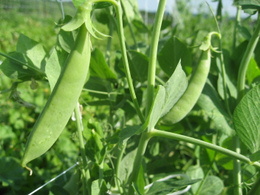Pea Growing Guide
Pea (Pisum sativum) are annuals and are usually the first thing that you can plant in your garden. Peas can be produced on bushy plants or on vines. The bush and vining peas can be the shelling or the edible podded varieties.
The bush varieties grow to about 2 to 3-feet tall depending on the variety. They do not need a trellis, but a stake or some form of support will help keep them from falling over.
The tall vining varieties should be planted on the north side of your garden so they can take advantage of the sunlight and will not shade other lower plants in your garden. This is also true for pole beans and corn which should be planted at the north side as well. You can adjust the location a bit because during the summer the sun is at a much higher angle and is almost overhead at noon.
Look at the seed package carefully before planting to determine if it is a vining variety that needs to be planted along a pea fence or a trellis.
Garden Peas
Garden peas are also known as shelling peas. They are picked after the seeds mature. After the pods are picked the pod is split open to release the individual peas. Freshly picked peas taste so much better than any you can buy.
Snow Peas
Snow Peas are an edible podded pea and are also known as sugar peas and China peas. The pod is flatter and the peas are smaller. They can be eaten fresh, stir fried as well as steamed.
Snap Peas
Snap Peas are a combination of garden peas and edible podded peas. The pods are more rounded and they can be eaten when the peas are mature and the pods are soft. Snap peas are very tasty with a crunchy sweet flavor. They can be cooked or eaten raw in a salad. The snap peas of the sugar variety are the most popular.
Soil Preparation
The soil should be nice loose well drained organic garden soil with the soil pH between 6.0 to 6.8. As soon as the soil is frost-free and can be worked, till the soil by digging down 8 to 12-inches turning the soil over with a garden fork. Remove any large rocks and stones. The small stones remaining will do no harm and actually benefit the soil by adding some micronutrients to the soil.
Covering the planting area with clear plastic about a week before planting your peas will speed up germination by warming up the soil.
Planting Peas
Peas are an early season crop and prefer a sunny location. In most areas they can be planted about 1-month before the last frost of the winter. They have a hard shell and to speed up germination it is helpful to soak them in water 12 to 24-hours before planting.
Peas and beans are in the legume family and have the ability of fixing nitrogen in the soil. If you have never grown them in the area where you are going to plant them it is helpful to inoculate them with rhizobium bacteria before planting them. This will often help increase yields. It can be found in garden centers.
For bush or dwarf varieties plant them 1 to 2-inches deep, 3 to 5-inches apart in rows 2-feet apart. Thin as needed, but allowing them to crowd each other a bit will keep the weeds down and help support each other. You can give them some support with some short stakes.
The vining climbing varieties can reach 4 to 6-feet in height and will need a pea fence or trellis to support them when they are a few inches tall.
For more detailed information visit the seed starting page.
Watering and Care
When the plants are a few inches tall add a nice loose mulch of shredded leaves or pine straw to shade the plant roots. This will keep the weeds out, the soil cooler and help retain moisture. Keep the mulch a couple of inches away from the stem. During dry spells give some water each week.
Harvesting Peas
The pea plants are shallow rooted and can be easily be pulled out of the ground. Use one hand to hold the pea pod and the other to hold the vine or use scissors to snip the stem.
Check your peas often as soon as the pods appear. The snow peas and snap peas can be picked at any time.
The garden or shelling peas can stay on longer since you want the peas within the pod to develop fully. Pick these when the pod is well filled but not bulging.
Popular Varieties
Garden peas for shelling: Dual, Maestro, Novella II.
Bush peas with edible pods: Oregon Giant, Oregon Sugar Pod II.
Vine peas for shelling: Garden Sweet.
Vine peas with edible pods: Sugar Snap, Super Sugar Snap.
Sources: Seeds Now, Burpee, Johnny’s Selected Seeds
Diseases
Wilt and powdery mildew: Plant as early as possible in a different area of the garden each year and use disease resistant varieties.
Pests
Aphids
are a major pest which is easily controlled by spraying the plants with
cold water to knock them off. Ladybug beetles and their larva as well
as lacewings are natural predators of aphids. Insecticidal soap and neem oil are also organic methods to control aphids.
Tips and Warnings
To increase the harvest period plant more every 2-weeks until it gets too warm. You can also plant varieties with different maturity dates.
Inspect your plants often for signs of disease and pests.
Garden Spikes newsletters give you timely information once or twice a month. Subscribe Free to the Garden Times newsletter below.
Your email address will only be used to send you a newsletter and will never be sold. You can unsubscribe at any time.

